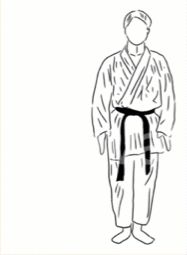Pattern
Choong-Moo
Kicks
- Quadruple kicks – multiple targets (same kick, same leg)
- Four consecutive kicks - multiple targets, more difficult kicks (same direction, same leg, same or different kick)
- Flying side pushing kick
- Flying side thrusting kick
- Flying 360° reverse hook kick (offensive)
- Flying twin foot front snap kick – 1 or 2 targets
- Flying twin foot side piercing kick – 1 target
- Mid-air 360° back piercing kick
Hand Techniques
- Inward strike with the knife hand
- Inward front strike with the reverse knife hand
- Inward block with the outer forearm
- Checking block with the x-knife hand
- Upward block with the twin palms
Stances
None
Step Sparring
- Advanced 1-step sparring (minimum of five sets)
- No-contact free sparring against two opponents
Tournament Competition
Participation in a minimum of 1 tournament within the previous 12 months required.
Training Requirements (Minimum)
- Students must complete a minimum of six months of active training at the 1st gup level before testing for 1st dan black belt. Active training is participating in an average of seven formal classes per month.
- Students must be a Level 3 Referee and work as a referee at a minimum of two tournaments.
Community Service
Consistent with the student oath and tenants of TaeKwon-Do, students must complete a minimum total of 10 hours of community service since beginning training as a White Belt to be eligible to test for 1st Dan Black Belt.
TTA Membership
Students must be a member of the TTA.
Seminars
Students must have attended a minimum of three (3) different TTA seminars in the previous 12-month period. NOTE: Since beginning as a White Belt, students are required to have attended a minimum of one (1) Kicking seminar, one (1) Technique/Patterns seminar, one (1) Referee/Sparring seminar, one (1) Self Defense/Ho Sin Sul seminar to be eligible to advance to Black Belt. Students are required to attend a minimum total of six (6) seminars since beginning training as a White Belt. It is recommended that students attend all of the different seminars made available at some point during their training from White Belt to 1st Dan Black Belt.
Ho Sin Sul
Time limit – Two minutes
To earn their black belts student must be able to perform a Ho Sin Sul approved by their instructor with realism. Ki-aps are required. No talking or hand signals are allowed between the students. Proper etiquette is also required. Ho Sin Sul partners should not be fellow testers or senior ranks unless permission has been granted by the testing board. Male participants may not use a female as their demonstration partner without prior approval.
Requirements: Two separate sets of three different Ho Sin Sul techniques each in succession followed by one set of four of the learned Ho Sin Sul techniques. No duplicates - black belt students must successfully demonstrate ten different Ho Sin Sul techniques.
Breaking
Adults – Hands
2-4 boards with Downward strike with the knife hand
Adults – Feet - Power
3-4 boards with Side piercing kick
Adults – Feet – Technique
- 1 suspended board with Any standing kick
- 1-2 boards – 1 target with Flying twin foot front snap kick or Flying twin foot side piercing kick
- 1 board – 2 targets with Flying twin foot front snap kick or Flying twin foot side piercing kick
Juniors – Hands
2 boards with Downward strike with the knife hand
Juniors – Feet - Power
3 boards with Side piercing kick
Juniors – Feet – Technique
- 1 suspended board with Any standing kick
- 1 board – 1 target with Flying twin foot front snap kick or Flying twin foot side piercing kick
- 1 board – 2 targets with Flying twin foot front snap kick or Flying twin foot side piercing kick
Pee Wees - Hands
1 board with Downward knife-hand strike
Pee Wees – Feet - Power
2 boards with Side piercing kick
Required Knowledge
Meaning of Black Belt
Black is the opposite of white, therefore, signifying the maturity and proficiency in TaeKwon-Do. It also indicates the wearer's imperviousness to darkness and fear.
Eight Parts of the Training Secrets of TaeKwon-Do
- To study the theory of power thoroughly.
- To understand the purpose and meaning of each movement clearly.
- To bring the movement of eyes, hands, feet, and breath into a single coordinated action.
- To choose the appropriate attacking tool for each vital spot.
- To become familiar with the correct angle and distance for attack and defense.
- Keep both the arms and legs bent slightly while the movement is in motion.
- All movements must begin with a backward motion, with very few exceptions.
- To create a sine wave during the movement by using the knee spring properly.

